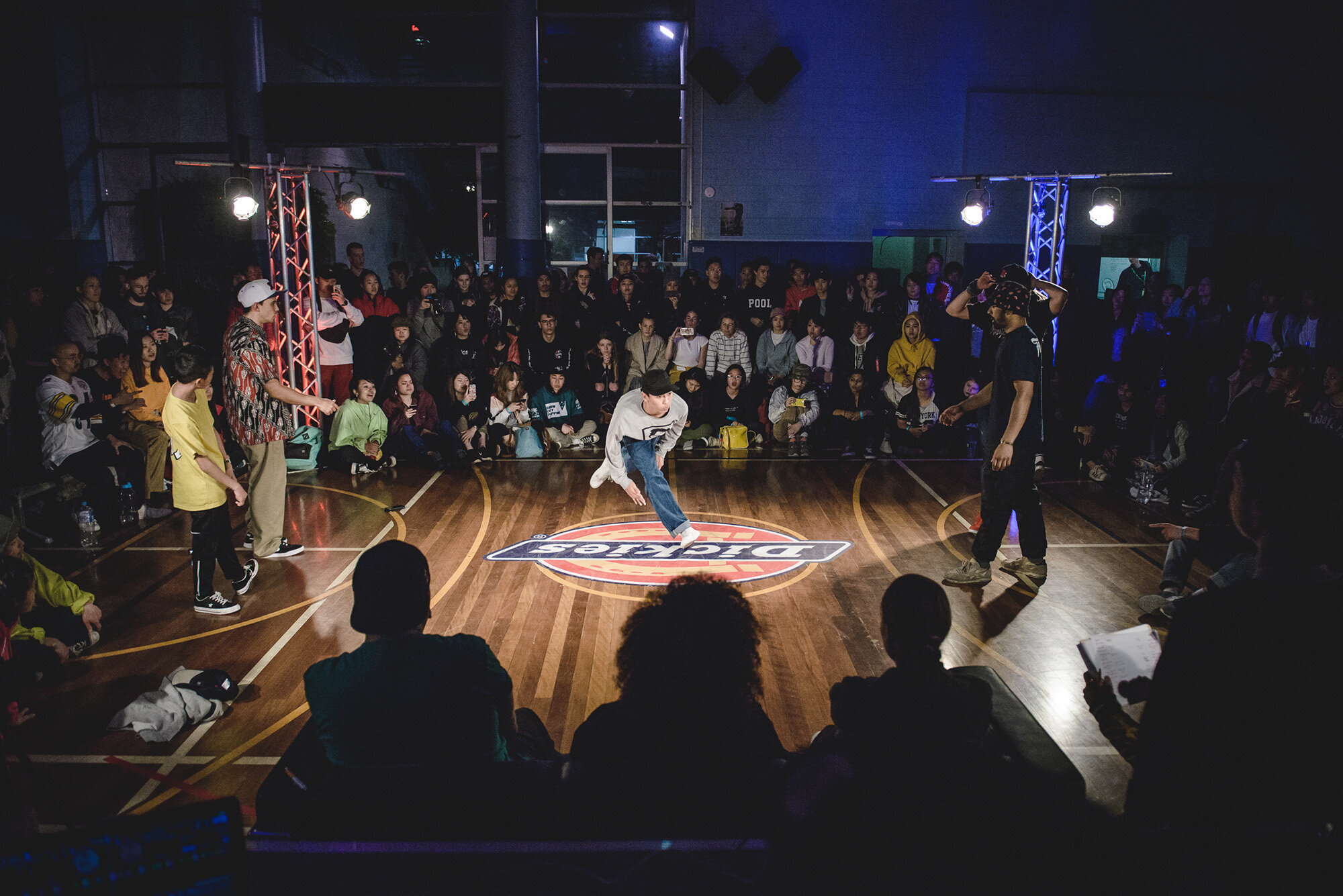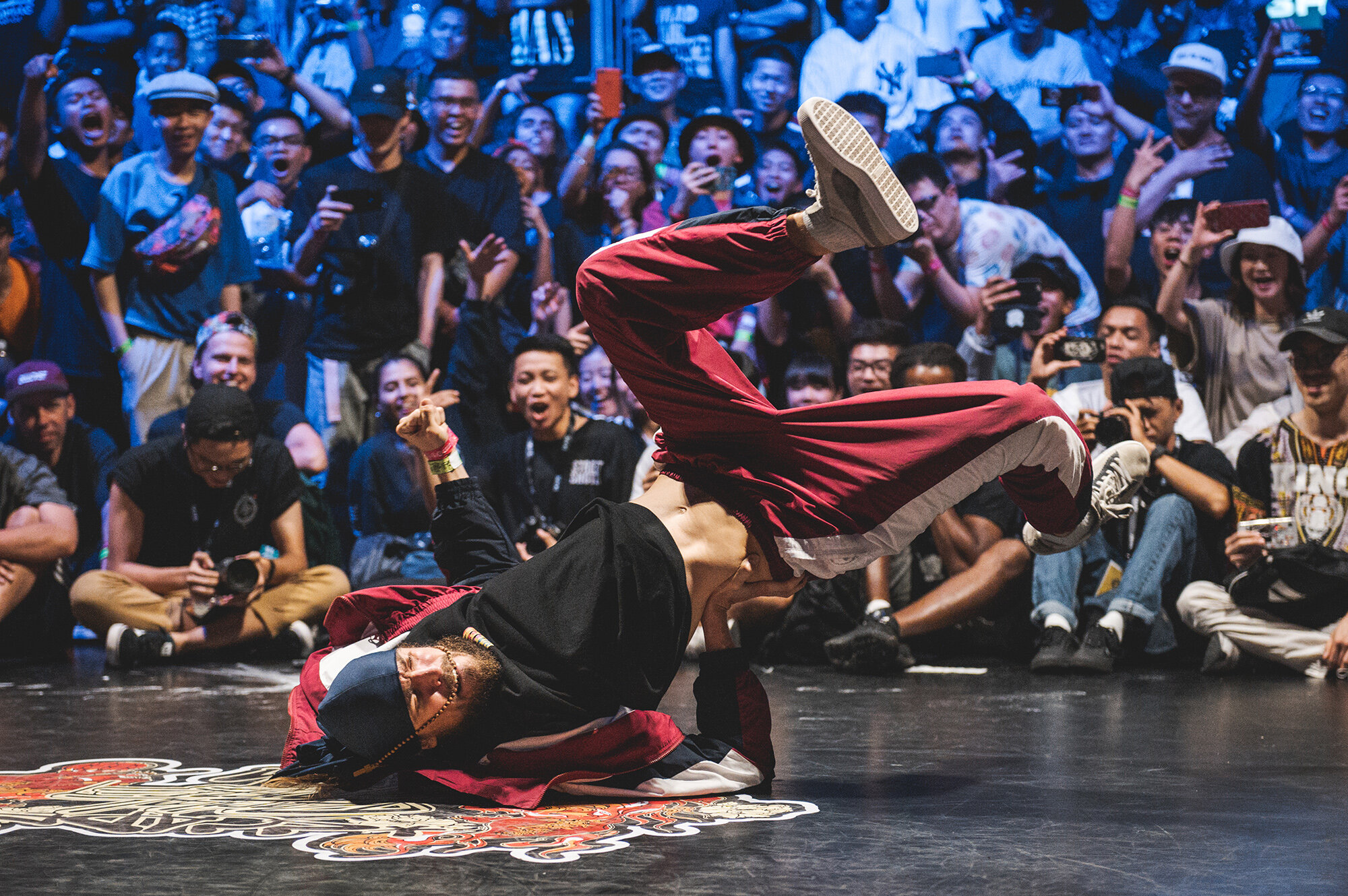.shooting street dance events
.Bboy Kill (Gamblerz Crew, KR) captured mid airflare at Destructive Steps X in 2018
(last updated September 2021)
A little backstory about me…
Before I ever considered taking up photography as a profession and got my first DSLR, I was shooting everything under the sun to feed my curiosity. It was street dance, however, that really piqued my interest and kickstarted my professional photography career (I wasn’t a dancer, by the way).
Back in 2013, I got invited through a mutual friend to come to a jam she was helping run and from there, I was hooked. The energy and power behind the movements completely captivated me and made me want to encapsulate that movement into a single frame. I started going to random local events to take photos, even though I didn’t know anyone. I was just a random in the scene. But I kept showing up to different events and slowly started sharing my images on Facebook, where they got shared around. Eventually, that led to my first professional gig shooting a battle in 2014. Anyway, enough about my history.
Shooting street dance events is great. They’re a lot of fun, filled with high energy, great music, good vibes, and amazing subjects to capture in both photo and video. It’s also a great place to practice and understand the fundamentals of photography: composition, lighting, camera settings, and even people skills (believe it or not).
I started my career from it, and I know many others who began their photography and videography journeys through dance. There’s some incredible talent out there producing amazing imagery, some of whom I’m still a massive fan of. But I also see a lot of mediocre, lackluster imagery, especially from newer photographers and videographers. (No shade to anyone in particular, I’ve taken my fair share of terrible shots too.)
So hopefully, with a few tips I’ve learned through years of experience, I can help you shoot better dance event photos.
.Bboy Wing (Jinjo Crew/Red Bull All Stars, KR) & Menno (Hustle Kidz Crew/Red Bull All Stars/Def Dogz, NL) with their falling tower routine at Radikal Forze Jam 2018
1) Know your place and understanding the space
One thing you quickly learn when shooting dance events is that you are not in control. You have no say over the space, lighting, dancers and their movements, timing, or the people around you. You can only capture what happens in front of you. Observe how big the battle area is. This affects your choice of focal length (more on that later) and where you position yourself. Respect everyone in the space: dancers, judges, DJs, organizers and the audience. Don’t be the person who gets in everyone's way.
.Bboy Taz (Hybrid Formz, AU) captured resting mid-air at a local Sydney jam, 2014
2) All of the lights
Try to understand:
Where the light sources are
What kind of lights they are
How they fall around the space and onto the dancers
This directly impacts how your images look and what camera settings you’ll need. Lighting sets the visual mood and ambiance of a jam. However, some organizers won’t have the budget or mindset to think of such. Smaller jams usually don’t have additional lighting. Larger ones often do, and some are even exceptionally lit. If the jam relies on natural light through windows or takes place outdoors, you’ll need to adjust your settings as light changes throughout the day. If it’s lit by house lights or fluorescent tubes, pay attention to your shutter speed and color rendering. The Color Rendering Index (CRI) may be low, which causes shifts in color, sometimes even in the same frame. Events with professional lighting usually offer higher CRI, meaning more consistent color.
Flash is also an option, but I recommend using it sparingly. Constant flashes can be distracting, especially during battles. With the number of photos I shoot, I’d definitely annoy people if I used flash the whole time. I usually reserve flash for portraits of the winners, runners-up or judges at the end of the jam or if the lighting is especially poor.
.intense battle between ReiNa (RHT/Criminalz Crew, JP) and GreenTeck (CA) at Radikal Forze Jam 2018
3) Camera settings
This is probably the question I get asked most often when it comes to shooting dance events.
As with all photography, you’re working with three key variables: shutter speed, aperture, and ISO. Your settings depend on the look you want and the lighting conditions.
Shutter speed: Because you're shooting motion, faster is better. While some recommend 1/1000s, that’s often not possible in indoor jams with limited lighting. I suggest using at least 1/400s for breaking and 1/250s for other styles. These speeds minimize motion blur. However, depending on how fast the movement is, you may still get some motion blur, especially in limbs.
Aperture: Unless the jam is outdoors during the day, you'll need a wide aperture to let in enough light. I typically shoot at f/2.8 using a 24–70mm lens. I’ve also used f/1.4 on a 35mm prime lens, which creates beautiful bokeh and allows for faster shutter speeds. However, the depth of field is so shallow that I often miss focus.
ISO: Don’t be afraid to raise your ISO. Many beginners fear grain, but a noisy photo is better than a blurry one. Even at well-lit jams, I might bump my ISO to 6400 to increase shutter speed. I've never received complaints about grain in my dance photos. If you're worried about image quality, look at photos from the pre-digital era or from professional dance photographers.
Focus: I almost always use autofocus. Manual focus is too slow for how quickly dancers move. I’ll lock focus or pre-focus if I anticipate the dancer staying in one spot. That said, autofocus can sometimes miss and focus on the crowd or background instead. It’s not perfect, but it’s the best option for dynamic movement.
.wide shot of Jiggy Jaya (Stale Bizkitz, AU) battling at Destructive Steps X in 2018
4) What to capture
First things first — you’re at a dance event, so of course, shoot the dancers while they’re battling. They are the main focus.
I usually stay in one spot for long stretches to avoid being disruptive. However, when possible, I switch up angles and focal lengths to add variety to my coverage.
Remember, battles aren’t the only thing happening. Organizers appreciate shots of the judges, DJs, MCs, and the crowd. Capturing dancers when they’re not dancing is also valuable as it helps tell a fuller story. These moments include handshakes after a round, pre-round focus, intense expressions, cyphers or people vibing during breaks.
As for capturing good battle photos, two major factors come into play: the dancer’s movement and your timing. If the dancer isn’t very strong, that will likely show in the photo, which you can’t control. Regarding your timing, understanding the rhythm, music and movement can really help predict the perfect moment. Even if you’re not a dancer, learning the style can improve your timing. Being able to spot the exact split second when the movement peaks is what separates dance photographers from general event shooters.
.MC Mike Magik pumping up the crowd at Radikal Forze Jam 2018 in Singapore
Once it’s over, you might have hundreds or even thousands of images to sort through. At any dance event I might capture anywhere between 1,000 to 10,000 images, depending on its size. Yes, it sounds excessive, but it works for me. I know photographers who take fewer shots and still get the moment. Do what suits you and your workflow. Just remember — the more you shoot, the more you’ll have to cull. I recommend multiple rounds of culling. You’ll end up with a stronger, more curated set of images instead of a large batch of mediocre ones.
When reviewing battle photos, here’s what I look for:
Strong composition
Good lighting
Clear, dynamic movement or poses
Facial expressions
Reactions from the crowd or judges
Some things I tend to avoid are shots where the dancer’s back is to the camera. They tend to be weaker images because you lose emotional connection in the face. Out of focus images also (for the most part) aren’t great as they’re signs that you misfocused. You can argue that it might look cool but I tend to see it as amateur. Unintentional blurry images due to slow shutter is also an amateur look in my opinion.
.Bboy Uzee Rock (Green Panda/Tatanaka Crew, UA) with his signature move the Uzeespin at Radikal Forze Jam 2019
Everything I mentioned isn’t the end all be all but hopefully this dump of random knowledge helps you with your photography and for the next time you shoot a street dance event. Check more of my images in the links below.







